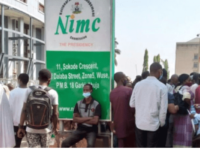Barely five days after their release, the new naira notes are allegedly being counterfeited by smart criminals in Nigeria. The Central Bank of Nigeria had, at the unveiling of the new notes, stated that they were loaded with security features which made them uneasy to counterfeit. To protect Nigerians from fraudsters and counterfeiters, the CBN released details and positions of the security features of the new notes.
At the front of the most significant denomination, the CBN showed close to its name a security feature of intaglio raised print, a portrait watermark, and optically variable ink in the form of a rectangular arrow pointing downwards. At the front of the N1, 000 notes is also a kinegram of the N1, 000 note. At the back of the N1, 000 denomination, are an Iridescent band, windowed metallic security thread, a see-through printing register and a raised intaglio print.
At the front of the new N500 note are hand-engraved portraits and windowed metallic security thread with CBN inscription. Others include optical variable ink, see-through printing in Register, and a raised intaglio print at the front. Almost the same features are replicated in the new N200 note, except for a gold patch with an embossed Coat of Arms.
Recently, Nigerians spotted fake versions of the new naira notes prompting the apex bank to issue guidelines on the security features. Many Nigerians rushed to the various banks in the country with the hope of cashing the new notes but were largely disappointed. Despite the mixed reactions that trailed the new notes, many banks complained of an inadequate supply. The Central Bank of Nigeria has, therefore, been advised to work to enlighten Nigerians with more information about the new naira notes and its features to aid its acceptability as a legal tender. The Chief Executive Officer of the Cowry Asset Management Limited, Johnson Chukwu, was reacting to viral videos of Nigerians who have refused to accept the new notes. He explained that the Central Bank of Nigeria has not done anything to put the required information out there for Nigerians to know what is new about the new notes apart from the colour. Many Nigerians are unaware of what the most striking physical changes in the notes are.
He suggested that if the bank puts out the necessary information about the notes, Nigerians would know how to identify the notes and accept them following reports of their being counterfeited across parts of the country. He disclosed that the current situation of the new notes being rejected is understandable with no information whatsoever from the Central Bank of Nigeria and the National Orientation Agency. He said people rejecting the notes are just doing what they believe is right by protecting their interest and capital.
He urged the Central Bank of Nigeria to embark on a public awareness campaign to explain the features of the new notes to Nigerians to expand its acceptability. He emphasized that this would help people in recognizing the difference between the fake and genuine notes and aiding its acceptability.
On whether the new policy would help reduce notes in circulation, he said the new notes would not give government the control that people expect. What the policy would do would be to ensure that government had more access to peoples’ incomes and enhance the government’s ability to improve revenue through taxes.

He said the tax authorities would have access to one’s revenue and are able to give a proper account of what an individual can and should pay. He described the current cash based transactions in the country as a means of circumventing the banking system and denying government revenue. He described the policy as one that would help the government to do better in terms of revenue collection, especially tax.
On the numerous bank charges on people’s accounts, he said most charges that people currently pay in Nigeria are nothing but over-charging was something a strong consumer advocacy could remove without any issues. He called for the removal of VAT and other charges on banking transactions positing that they impede business development and operations by eroding operations capital of businesses especially for Small and Medium Scale Enterprises.
In a related development, First City Monument Bank (FCMB), and Fidelity banks have been recognized as leading the pack of best-performing commercial banks in Nigeria in the Quarter 3 of 2022. An analysis of the banks’ equity and financials shows that 13 banks made the sum of N298.84 billion as profit before tax between July and September of 2022, showing an increase of 29.9 per cent compared to N228.54 billion recorded the same period the previous year.
The banks remained strong despite solid headwinds, in which Nigeria’s GDP slowed to 2.25 per cent from 3.54 per cent in the previous quarter and 4.03 per cent in the same quarter of 2021. The banks witnessed a 5 per cent increase in customer deposits during the period under review to stand at N43.68 trillion as of September 2022 from N41.61 per cent as of June 2022.
Four of the 13 banks recorded positive growth in their share price in the third quarter of this year in the local equities market. The 13 banks recorded an average cost-to-income ratio of 64.96 per cent in the period under review, compared to 69.11 per cent in the same period last year. The National Bureau of Statistics, NBS, said that the banks recorded slowed growth, saying that the banking sector slowed from 20.06 per and 25.5 per cent recorded in the second quarter of 2022 and 2021, respectively, to 12.03 per cent during the period under review.

NBS reports that this is the slowest quarterly growth since the first quarter of 2021, when the economy was recovering from the COVID-19 pandemic.
The 13 banks under consideration grew their assets by 4 per cent from N63.59 trillion recorded as of June 2022 to N66.13 trillion by the end of September 2022, representing an N2.54 trillion increase in three months. The top banks in this category are: Zenith Bank and First Bank, which recorded the highest asset value during the period under review, but the banks changed position in terms of growth rate.
First position was Zenith Bank. Second position was FCMB. Third position was Union Bank. Fourth position was Jaiz Bank. Customer deposits to the thirteen banks increased by 5% in the third quarter of 2022 to stand at N43.68 trillion from N41.61 trillion recorded as of June 2022. Access, Zenith and UBA recorded the highest customer deposits as of September 2022. Meanwhile, below are the leading banks by growth in customer deposits in Quarter 3, 2022.
First position – Zenith Bank; Second position – FCMB; Third position – Jaiz Bank; Fourth position – Union Bank; Fifth position is First Bank. The loan books of the twelve banks (Jaiz Bank excluded) that reported their customer loans grew by 5.5% to stand at N23.76 trillion as of September 2022 from N22.53 trillion recorded as June 2022. A bank loan is an important metric used to assess banks’ performance. Notably, loans allow for growth in the overall money supply in an economy and they actually open up competition by lending to new businesses.
The interest and fees from the loans also form a significant part of banks’ earnings. As of the period under review, Access Bank boasts the most potent loan book at N4.62 trillion, followed by Zenith Bank and First Bank with N3.88 trillion and N3.6 trillion, respectively. First position was Zenith Bank; Second position – Union Bank; Third position – UBA; Fourth position – IBTC Bank; Fifth position – First Bank. The 13 banks posted a profit after tax of N296.84 billion in Q3 2022, an increase of 29.9 per cent from N228.54 billion recorded in 2021.
In terms of profit after tax, Zenith, GTCo and Access Bank led the list of banks with the highest gain. The overall ranking by performance showed that FCMB leads the pack, followed by First Bank and Fidelity Bank. The market capitalization is, in other words, the cumulative value of the banks. It is calculated by multiplying the total units of shares held by the price of the shares. Typically, the positions would be comprised of the tier-1 banks in Nigeria which are sometimes known as FUGAZ (First Bank, UBA, GT Bank, Access Bank and Zenith Bank), but for the period under our scope, UBA lost its position on the list to Stanbic IBTC.




